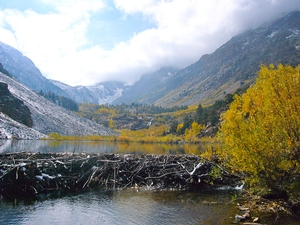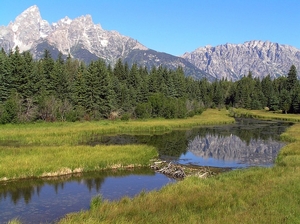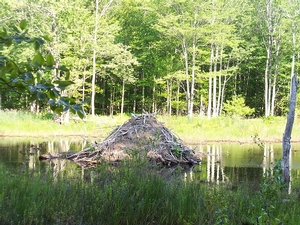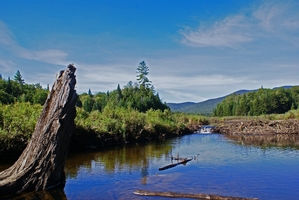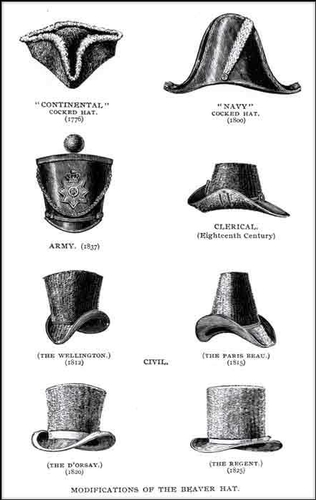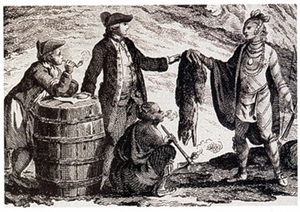In the 1600s, as European colonists began exploring North America, a fur trade formed between the Dutch, French, and English. Beavers played an important role in this fur trade due to the high value of their pelts. Beaver pelts were the first great trade commodity in America. Many fur companies established themselves in the Northeast as the revenue from beaver pelts fueled the economy. The establishment of the North American fur trade coincided with the depletion of European beaver populations, so beavers were in high demand. The main reason for the high demand for beaver pelts was the increasing demand for beaver hats in England and France. Beaver hats became the height of fashion and symbolized a person's status, social standing and status. In seventeenth century England, the style and shape of one's hat often revealed the person's religion and political leanings. Beaver fur was great for hat making because it was dense, durable, waterproof and held shape well. The most expensive and highest quality hats were made from the undercoat of a beaver while the lower quality, half-beaver hats could be made of beaver fur mixed with hare fur or wool. Below is a picture showing many different styles of hates made from beaver fur.
The English, French and Dutch all found ways to work with Native Americans to gain access to beaver sources in the Northeast. The Native Americans who had been hunting in the Adirondacks for many years had superior hunting and trapping skills as well as a superior familiarity with the land. Beaver trade established a good exchange between Europeans and the Native Americans as well as establishing enemies and alliances. Competition for beavers led to warfare between several Native American nations and the colonists.
From the late seventeenth century to the mid nineteenth century, beaver fur was in its greatest demand; most members of European society wanted beaver products. It was reported in 1671 that Dutch traders shipped almost 80,000 pelts to Europe (Warren). Due to the heavy demand for beaver pelts in the seventeenth and eighteenth centuries, beavers were almost completely driven to near extinction in the northeastern part of America making beaver hats very expensive. 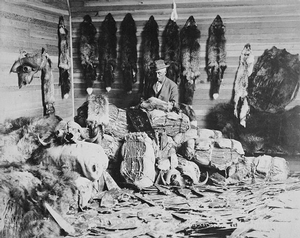 Consequently, the beaver hat's popularity declined and by the end of the 19th century, silk hats had replaced beaver hats as the new fashion. By 1890, most of New York was devoid of beavers except for a few communities that survived in remote locations in the Adirondack Park, such as the remote northwest area of Upper Saranac Lake in Franklin County. These communities were so few and isolated that many thought the species was extinct. In the 1890s, a state zoologist even declared the beaver to be extinct. For comparison purposes, in 1600, in Northern New York, it is estimated that there were at least 1,000,000 beaver, and in 1860, there were perhaps 50. It is said that these few beaver sparked a renewed interest locally, which led to their reintroduction in the twentieth century.
Consequently, the beaver hat's popularity declined and by the end of the 19th century, silk hats had replaced beaver hats as the new fashion. By 1890, most of New York was devoid of beavers except for a few communities that survived in remote locations in the Adirondack Park, such as the remote northwest area of Upper Saranac Lake in Franklin County. These communities were so few and isolated that many thought the species was extinct. In the 1890s, a state zoologist even declared the beaver to be extinct. For comparison purposes, in 1600, in Northern New York, it is estimated that there were at least 1,000,000 beaver, and in 1860, there were perhaps 50. It is said that these few beaver sparked a renewed interest locally, which led to their reintroduction in the twentieth century.
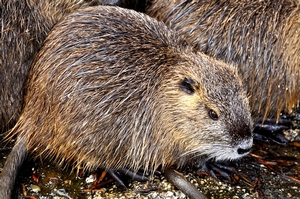 Due to the scarcity of beavers in the Adirondack Park, many people felt the need to reintroduce the animal. Initially, a few well-known landowners including Edward H. Litchfeild, Timothy L. Woodruff, and George A. Stevens tried to reintroduce the species in the early 1900s. A few years later the state attempted to scatter eight beaver throughout the Adirondacks; these beaver were captured from Yellowstone National Park. Four beavers were dead upon arrival but the remaining four were released and soon migrated to ponds and streams. In the following months, the state released several more beavers on state owned land in the Park. This introduction of the beaver was highly successful. By 1910, the beavers had spread throughout the park, flooding woodlands and building lodges along the way. And in 1915, fifteen thousand beaver were estimated to be living in New York. Since its reintroduction, the species has continued to increase as a result of protective laws for the beaver passed in 1895 and 1904, favorable public interest in protecting the beaver and a lack of wolves, one of the beaver's natural predator in the park. Although there are no wolves currently in the Adirondacks bears and coyotes in the park do their job in controlling the beaver population.
Due to the scarcity of beavers in the Adirondack Park, many people felt the need to reintroduce the animal. Initially, a few well-known landowners including Edward H. Litchfeild, Timothy L. Woodruff, and George A. Stevens tried to reintroduce the species in the early 1900s. A few years later the state attempted to scatter eight beaver throughout the Adirondacks; these beaver were captured from Yellowstone National Park. Four beavers were dead upon arrival but the remaining four were released and soon migrated to ponds and streams. In the following months, the state released several more beavers on state owned land in the Park. This introduction of the beaver was highly successful. By 1910, the beavers had spread throughout the park, flooding woodlands and building lodges along the way. And in 1915, fifteen thousand beaver were estimated to be living in New York. Since its reintroduction, the species has continued to increase as a result of protective laws for the beaver passed in 1895 and 1904, favorable public interest in protecting the beaver and a lack of wolves, one of the beaver's natural predator in the park. Although there are no wolves currently in the Adirondacks bears and coyotes in the park do their job in controlling the beaver population.
 Because of the beaver's amazing recovery in the park, special trapping seasons were created in 1924 and 1925 to control the populations. The state also issued special permits for people to remove "nuisance" beavers flooding their summer cottages or causing other kinds of damage to their property. The success of these trapping seasons led to the start of regular trapping seasons beginning in 1928. To learn more about beaver trapping in the Adirondacks and beavers in the park today please click on the "Beavers in the Adirondacks today" tab.
Because of the beaver's amazing recovery in the park, special trapping seasons were created in 1924 and 1925 to control the populations. The state also issued special permits for people to remove "nuisance" beavers flooding their summer cottages or causing other kinds of damage to their property. The success of these trapping seasons led to the start of regular trapping seasons beginning in 1928. To learn more about beaver trapping in the Adirondacks and beavers in the park today please click on the "Beavers in the Adirondacks today" tab.
Sources:
1. "The beaver hat, then and now," http://oloverhats.com/blogs/oloverhats-weblog/10748501-the-beaver-hat-then-now.
2. "A brief history of the beaver trade," http://cwh.ucsc.edu/feinstein/A%20brief%20history%20of%20the%20beaver%20trade.html.
3. "Beaver hats build a nation," http://www.georgianindex.net/America/Hats/Beaver.html.
4. Jenkins, Jerry and Andy Keal. "The Adirondack Atlas."
4. Rue, Leonard Lee and John K. Terres. "The World of the Beaver."
5. Radford, Harry, "Artificial Preservation."
6. Warren, John. "Extinction: A Short History of Adirondack Beaver."
Images from top to bottom:
1. Roy Saplin. Flikr. Creative Commons
2. http://www.georgianindex.net/America/Hats/Beaver.html
3. http://upload.wikimedia.org/wikipedia/commons/7/74/Fur_traders_in_canada_1777.jpg
4.http://pixabay.com/en/nutria-rat-myocastor-coypus-coypu-273577/
5.https://www.google.com/search?site=imghp&tbm=isch&q=beaver%20traps&tbs=sur:fmc#tbs=sur:fmc&tbm=isch&
6. Creative Commons
7.http://beavercontrol.us/wp-content/uploads/2012/02/beaver_belisle_trap.jpg
